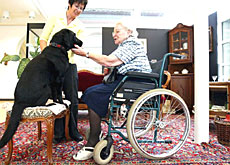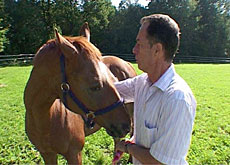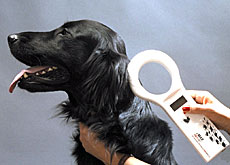Dog therapy catches on in Switzerland

Switzerland’s shaggy St Bernards have a long history of bringing help to those in need.
Now other breeds are flying the flag for caring canines as so-called visiting or therapy dogs in what is a relatively new phenomenon in the country.
Although the idea has been around for about a decade, it is only in the past three years that the Swiss have used specially trained dogs for social and therapeutic purposes.
Across the whole of Switzerland, only cantons Bern and Basel are involved in using visiting or therapy dogs. Other cantons have adopted a wait-and-see attitude.
“It is not well known here, so there’s a certain amount of scepticism,” said Jacques Ditesheim of the Swiss School for Guide Dogs for the Blind in Allschwil near Basel.
Canine recruits
Therapy dogs are recruited from the ranks of those which fail to make the grade as guide dogs for the blind.
They then undergo a separate training regime with their owner before going on visits to the elderly and children with special needs.
Whereas in some countries animal-assisted therapy focuses on training the owner, in Switzerland training the dog is at the forefront, says Ditesheim.
The therapy dogs, almost all of them Labradors, are trained step-by-step to become familiar with as many diverse situations as possible that they might encounter.
For example, the dogs need to learn how to walk next to wheelchairs and on slippery floors; get used to the cries of patients, slamming doors, and falling objects; accustom themselves to people wearing different types of clothing; and get used to people whose movements are unusual.
Protecting their dogs from overexertion and recognising stress signals are two key responsibilities of the owners.
Making a difference
Up to now, Ditesheim’s experience with therapy dogs has been generally positive, but not always. He says sometimes people do not accept or have no interest in the dogs, or vice-versa.
Ditesheim himself is cautious with the expression “therapy dog”. If after a year he sees that a special-needs child or an elderly person has made noticeable progress, only then, he says, does the expression “in its broadest sense” have relevance.
While some remain sceptical of the difference that therapy dogs can make to people’s lives, others are firmly convinced of the benefits.
“We have an open door policy with regards to animals,” said Paul Otte, director of a Lucerne retirement home.
“In fact people are allowed to bring their pets with them when they move in. It gives them continuity and keeps them active.”
However, if owners are unable to feed or care for their animals themselves, they cannot be brought into the home. This is where visiting dogs fill in the gap.
Studies have proven that pets have a positive effect on humans.
Pets are sources of humour and playfulness for people.
Animals can help people overcome sorrows and help with depression.
Generally speaking, the term “animal-assisted activities” describes informal visits with specially trained dogs for the purposes of social or therapeutic companionship.
“Animal-assisted therapy” refers to visits that are part of a formal therapeutic programme.
Visiting or therapy dogs are specially trained for this work. They are often used in homes for the elderly, the handicapped, and the sick.
(Adapted from German by Kathleen Peters)

In compliance with the JTI standards
More: SWI swissinfo.ch certified by the Journalism Trust Initiative



You can find an overview of ongoing debates with our journalists here . Please join us!
If you want to start a conversation about a topic raised in this article or want to report factual errors, email us at english@swissinfo.ch.